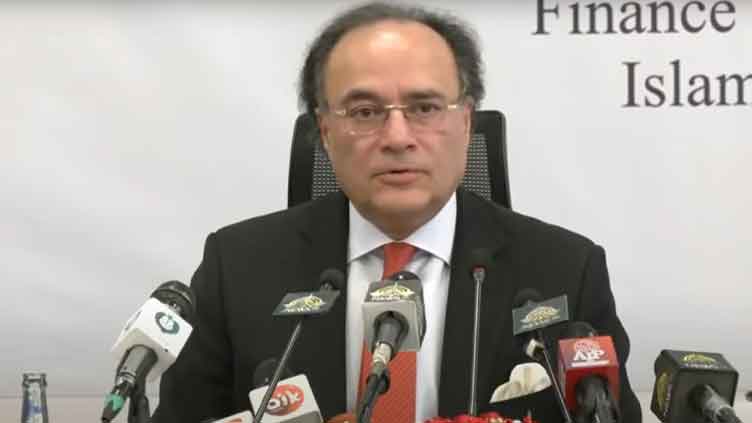Economic Survey 2024-25: Inflation drops to 4.6% as GDP grows by 2.7%

Business
FinMin says Policy rate has been reduced significantly from 22% to 11%
ISLAMABAD (Dunya News) –Federal Minister for Finance and Revenue Senator Muhammad Aurangzeb unveiled the Economic Survey for the fiscal year 2024–25, a key pre-budget document that outlines the government’s assessment of the national economy.
Addressing a presser, the finance minister said that the policy rate had been reduced significantly from 22% to 11%, a strong indicator of stabilizing economic conditions.
“We are moving towards stability,” the minister remarked, adding that he appreciates the constructive steps taken by the caretaker setup.
Discussing macroeconomic performance, the finance minister stated that Pakistan’s GDP growth in the current fiscal year reached 2.7%, a significant rebound from 2023, when the country experienced negative growth.
“In 2024, our GDP growth was recorded at 2.5%, while the global GDP growth for 2025 is estimated at 2.8%,” he added.
Inflation has also seen a remarkable decline. "In 2023, inflation had surged beyond 29%. Today, we have brought it down to just 4.6%," he shared, crediting economic management reforms for the turnaround.
The Economic Survey serves as a vital document ahead of the annual federal budget, offering detailed insights into the country’s socio-economic performance over the outgoing fiscal year.
Here is the copy of the Economic Survey 2025-26.
The finance minister stated that Pakistan experienced a significant increase in foreign exchange reserves during the current fiscal year, while also implementing crucial structural reforms aimed at transforming the economy’s DNA.
He emphasised the importance of long-term reforms, stating, “We have merged several departments and ministries to streamline governance. Structural reforms are essential for sustainable growth. The debt-to-GDP ratio has declined from 68% to 65%, and public finance management has improved.”
He noted that the reduction in the policy rate last year helped save significantly on debt servicing. “IMF support restored our confidence. The IMF programme is focused on sustainable economic stability and has provided the necessary resources for structural reforms,” he said.
Aurangzeb highlighted that the tax-to-GDP ratio reached a five-year high, largely due to increased use of technology in tax collection. “We’ve made major strides in energy sector reforms, appointed professional boards in DISCOs, and reduced distribution losses,” he added.
Read also: GDP, agriculture miss targets as Economic Survey 2024–25 set to be unveiled today
Commenting on the power sector, the finance minister stated that reforms had already yielded a historic recovery within one year. “Every transformation takes two to three years, but improvements in governance of power distribution companies are visible.”
He credited Federal Ministers Awais Leghari and Ali Pervaiz Malik for fast-tracking energy reforms. “Private sector professionals on DISCO boards have improved performance, and we’ve reached an agreement with banks to address the Rs 1.27 trillion circular debt.”
Further, Aurangzeb noted that the government is shifting toward a defined-contribution pension system as part of pension reforms. “We are focused on plugging leakages through right-sizing—43 ministries and over 400 attached departments are under review. I will outline the next steps in the upcoming budget.”
The finance minister shared key highlights of Pakistan’s economic performance for the current fiscal year, projecting remittances to reach $38 billion. He noted a significant rise in retail registration to 74%, while the current account remained in surplus at $1.9 billion from July to April.
The tax-to-GDP ratio reached a five-year high, with imports increasing by 16.5%. Freelancers in the IT sector contributed $400 million in earnings, showcasing the sector’s growing potential.
Commenting on national security, the Minister said, “Our armed forces gave a strong response to Indian aggression. We’ve also been fighting an economic battle—on both fronts, Pakistan has shown its strength.”
Aurangzeb acknowledged challenges in the external sector, noting a dual crisis in recent years. He highlighted that the Special Investment Facilitation Council (SIFC) is focusing on energy, IT, agriculture, and mining. “Local investors will attract foreign ones,” he said, adding that Rs800 billion was saved in debt payments, with financial institutions backing Pakistan.
He emphasized that any savings from debt repayments will be redirected to other key sectors. Industry grew by 6%, the services sector by over 2%, and real estate and construction by 3%, while agriculture saw modest growth of 0.6%.
Exports increased by 6.8% to $27.3 billion, and the economy’s total size rose from $372 billion to $411 billion. Per capita income also grew by $162, reaching $1,824.
The minister revealed that the government will now borrow on its own terms from the private sector. This year saw a doubling in the number of individual tax filers. Overseas Pakistanis are increasingly investing through Roshan Digital Accounts.
He labeled PASSCO as a hub of corruption, saying reforms are on the way. Remittances have increased by nearly $10 billion in two years, and rising machinery imports signal a healthy economy.
However, agriculture faced mixed outcomes: key crop production fell by 13.49%. Potato and onion production rose by 11.5% and 15.9% respectively, but declines were seen in maize (15.4%), rice (1.4%), cotton (30%), wheat (8.9%), and sugarcane (3.9%).


